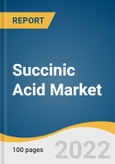The global succinic acid market size is expected to reach USD 512.8 million by 2030, registering a CAGR of 9.7% during the forecast period. The growth is attributed to a surge in demand from the end-use industries, such as food & beverages, pharmaceutical, and personal care & cosmetics. In the food & beverages industry, Succinic Acid (SA) is used as a food additive in dietary supplements and food preservation. In the pharmaceutical industry, the product finds application in the preparation of vitamin A and many anti-inflammatory products. It is also used in the formulation of cosmetics and personal care products, such as toothpaste, perfumes, nail polish, and liquid soaps.
Succinic acid is produced from Liquefied Petroleum Gas (LPG). Petroleum gas is often expensive. As an alternative to LPG-based production, succinic acid is generated by different microbes and is naturally formed by undertaking the process of anaerobic digestion. It is regarded as a common organic acid that is used in a variety of applications. Bio-based SA is similar in structure to petroleum-based products. However, it helps reduce carbon emission, as well as optimize and enhance the performance of the acid. Rising customer preference for biodegradable plastics and other greener materials is a key factor driving the market growth.
The COVID-19 pandemic crippled economies across the globe and severely impacted the supply chains across industries. The supply chain of raw materials for succinic acid production was drastically impacted, changing the production and consumption patterns globally. The industrial end-use segment dominated succinic acid consumption over the last decade. But a halt in the production of non-essential chemicals, ingredients, or industrial products during the pandemic hampered the demand for starting materials, adversely impacting the demand. However, with the lifting of lockdowns and movement restrictions, the market is expected to witness a steady rise in demand.
Succinic acid is produced from Liquefied Petroleum Gas (LPG). Petroleum gas is often expensive. As an alternative to LPG-based production, succinic acid is generated by different microbes and is naturally formed by undertaking the process of anaerobic digestion. It is regarded as a common organic acid that is used in a variety of applications. Bio-based SA is similar in structure to petroleum-based products. However, it helps reduce carbon emission, as well as optimize and enhance the performance of the acid. Rising customer preference for biodegradable plastics and other greener materials is a key factor driving the market growth.
The COVID-19 pandemic crippled economies across the globe and severely impacted the supply chains across industries. The supply chain of raw materials for succinic acid production was drastically impacted, changing the production and consumption patterns globally. The industrial end-use segment dominated succinic acid consumption over the last decade. But a halt in the production of non-essential chemicals, ingredients, or industrial products during the pandemic hampered the demand for starting materials, adversely impacting the demand. However, with the lifting of lockdowns and movement restrictions, the market is expected to witness a steady rise in demand.
Succinic Acid Market Report Highlights
- The bio-based type segment is estimated to register the fastest CAGR from 2022 to 2030 due to the increasing carbon footprint of petro-based products, price fluctuation of fossil fuels, and growing preference for locally-produced raw materials.
- The industrial end-use segment is expected to register the fastest CAGR from 2022 to 2030 due to a wide application scope of the product as a raw material to produce numerous chemicals.
- The product is used to develop biodegradable polyesters and polyurethanes, which are further used in paints, plastics, pesticides, rubber, nylon, solvents, and other industries.
- Asia Pacific is projected to record the fastest CAGR from 2022 to 2030 due to the factors such as easy availability of low-cost labor and raw materials, growing disposable income, changing consumer lifestyles, and rapid growth of the packaging industry.
- The global market is highly competitive due to the presence of many multinational companies. These companies take strategic decisions, such as mergers & acquisitions, joint ventures, and partnerships to gain a competitive advantage over others.
Table of Contents
Chapter 1. Methodology and Scope
Chapter 2. Executive Summary
Chapter 3. Succinic Acid Market : Type Estimates & Trend Analysis
Chapter 4. Succinic Acid Market: End-use Estimates & Trend Analysis
Chapter 5. Succinic Acid Market: Regional Estimates & Trend Analysis
Chapter 6. Succinic Acid Market: Competitive Analysis Estimates & Trend Analysis
Chapter 7 Succinic Acid Market: Company Profiles
Companies Mentioned
- Thyssenkrupp AG
- Merck Kgaa
- Ernesto Ventos S.A.
- Prochem, Inc.
- the Chemical Company
- Sae Manufacturing Specialist Corp.
- Purac
- Anhui Sunsing Chemicals Co. Ltd.
- Gadiv Petrochemical Industries (Israel)
- Basf Se
- Kawasaki Kasei Chemicals Ltd.
- Mitsubishi Chemical Corporation
- Myriant Corporation
- Succinity GmbH
- Bioamber
- Nippon Shokubai (Japan)
Methodology

LOADING...
Table Information
| Report Attribute | Details |
|---|---|
| No. of Pages | 100 |
| Published | April 2022 |
| Forecast Period | 2022 - 2030 |
| Estimated Market Value ( USD | $ 234.8 Million |
| Forecasted Market Value ( USD | $ 512.8 Million |
| Compound Annual Growth Rate | 9.7% |
| Regions Covered | Global |
| No. of Companies Mentioned | 16 |









